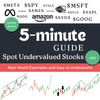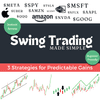📊 Popular Stock Analysis
Free Cash Flow Margin (FCF Margin) - Revenue Lies. Profit Misleads. This Tells the Truth.
Tue, Jun 10, 2025
Table of Contents
- What is the free cash flow margin (FCF margin)?
- Ok, but isn’t that just profit?
- Do any big companies actually have strong FCF margins?
- Should you always pick companies with high FCF margin?
- What’s considered a good free cash flow margin?
- How do you actually calculate FCF margin?
- Is it better than looking at earnings?
- When does FCF margin get weird?
- What should you actually *do* with this?
- Worth keeping on your radar
A company can report huge numbers in revenue or profit
But that doesn’t always mean it’s doing well.
Sometimes the only question worth asking is —
How much do they actually keep?
That’s what the free cash flow margin tells you.
Not what they earned, not what they claim they’ll earn,
Just what’s left over after paying for the stuff that actually keeps things running.
What is the free cash flow margin (FCF margin)?
Alright, imagine you run a food truck.
You pull in $1,000 in sales on a decent day.
After covering ingredients, gas, paper cups, and your buddy who helps on weekends,
you’re left with $150.
That $150? That’s your free cash flow —
money you can actually use — to grow, to save, or to chill.
Take that $150, divide it by the $1,000 you made,
and you get a 15% free cash flow margin.
Means you’re keeping 15 cents on every dollar that comes in.
Super simple — but it says a lot.
Ok, but isn’t that just profit?
Not really.
Profit is what you report after expenses on paper,
but it includes stuff like depreciation and other accounting weirdness.
You can technically have profit and still be strapped for real cash.
Free cash flow is colder.
Cleaner.
It’s cash you actually have after operations and investments are handled.
And FCF margin just puts that into context —
How efficient are you at turning revenue into usable leftover money?
Do any big companies actually have strong FCF margins?
Yeah, a bunch.
Apple (AAPL) makes around $386B in revenue,
keeps about $100B in free cash flow.
FCF margin? Roughly 26%.
Microsoft (MSFT) brings in about $252B,
keeps around $67B.
FCF margin? Around 27%.
Google (GOOGL) pulls in $335B in revenue,
generates about $72B in free cash flow.
FCF margin? Close to 21%.
Then you’ve got Amazon (AMZN).
Revenue’s massive — around $575B,
but they keep just about $9B,
so their FCF margin is more like 1.6%.
It still works for them, but it shows how tight things are when you’re in retail and logistics.
Should you always pick companies with high FCF margin?
Not always.
Some businesses just run leaner by nature.
Retail, shipping, airlines — low margin’s kinda built in.
Doesn’t mean they’re badly run.
But if a company is growing like crazy and still keeping a solid chunk of cash?
That’s usually a good sign.
What matters is whether their FCF margin is holding steady, going up, or slowly disappearing.
What’s considered a good free cash flow margin?
Depends on the type of business, honestly.
A solid software company? 20%+ is good.
A capital-heavy manufacturer? Even 10–15% could be solid.
Anything below 5% — you just want to know why.
It’s not one-size-fits-all.
Context matters way more than the raw number.
How do you actually calculate FCF margin?
Real easy.
Look up the company’s free cash flow,
then divide it by their total revenue.
So like:
FCF margin = (free cash flow) / (revenue)
For example:
The company makes $500M in revenue,
keeps $75M in free cash flow.
75 ÷ 500 = 0.15
= 15% FCF margin
You can grab those numbers from their 10-Qs or 10-Ks,
or pull them from places like TradingView or Yahoo Finance.
Tools like Personal Capital are also helpful for keeping track if you’re managing multiple accounts.
Is it better than looking at earnings?
In a lot of cases, yeah.
Earnings can be messy — full of adjustments, assumptions, whatever makes the report look nice.
FCF margin?
Harder to fake.
More grounded.
It’s not the only thing to look at,
but it’s one of the most honest ones.
When does FCF margin get weird?
Couple of times you wanna be cautious:
- If a company’s investing a lot in growth, margin might look low short-term.
- Some businesses are seasonal, so one quarter might look off.
- A spike in working capital can mess with free cash flow in the short run.
- High margin for one quarter could just be from selling off stuff — not repeatable.
Also, just don’t compare across industries randomly.
Like don’t pit AMZN against MSFT.
Compare AMZN to WMT or TGT —
That gives you more useful context.
What should you actually do with this?
When you’re looking at a company,
Check its free cash flow margin over the last few years.
See if it’s steady,
growing,
or sliding.
Pair it with a few other things:
- How much debt do they have
- How often do they need to raise cash
- Whether they can cover investments and still breathe
If a company is growing fast but burning through cash,
you gotta ask: is it temporary? Or are they just scaling inefficiently?
FCF margin won’t give you all the answers —
but it’ll help you ask better questions.
Also — if you’re starting out and want a low-effort way to explore investing,
Apps like Acorns or Robinhood can be useful for experimenting without needing to pick stocks manually.
Worth keeping on your radar
Free cash flow margin doesn’t get talked about much,
but it quietly tells you a lot.
Not about what a company says it’s worth —
but how much money it actually keeps when the dust settles.
And that’s probably one of the more useful signals in a world full of noise.
Not financial advice, just sharing my thoughts!
Related Posts
High ROIC = High Returns? Not Always. Here’s What Most Investors Miss
Fri, May 30, 2025
Learn how ROIC shows if a company uses money wisely, why it matters to investors, and how to spot red flags using real examples.
Return on Equity (ROE) Explained: How Smart Investors Use This Metric to Pick Winning Stocks
Sun, Apr 20, 2025
Learn how Return on Equity (ROE) helps investors spot profitable stocks, avoid value traps, and make smarter investment decisions with real-world examples.
🌟 Buy Me Coffee
Love the market insights, stock analyses, and investing tips I share? Help me do more by buying me coffee. Your support funds deeper research, keeps content ad-free, and helps create more tools and resources for the community.




